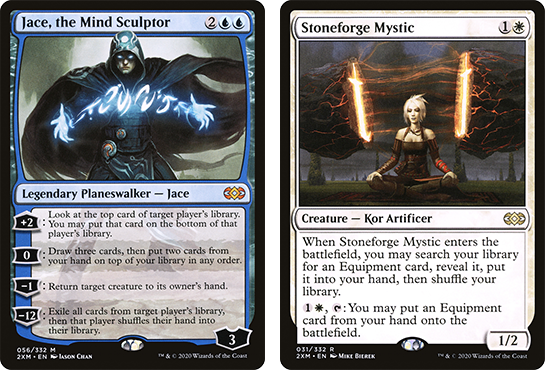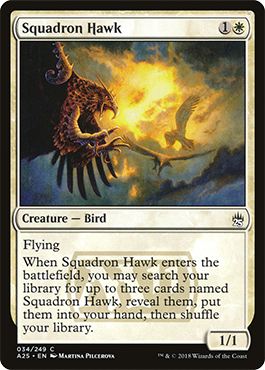Nizzahon looks at a significant event on this day in MTG history. On June 20th, 2011, Jace and Stoneforge Mystic were banned!
Welcome to another edition of “This Day in Magic History.” Today, we’re taking a look at the banning of Jace, the Mind Sculptor and Stoneforge Mystic in Standard, which was announced eleven years ago today, on June 20th, 2011. This announcement is one of the most famous in the history of Magic, because the two cards were so incredibly powerful that they were utterly dominating the Standard format. As hard as it is for us to imagine these days, it came at a time when Standard bans were incredibly rare. In fact, this was the first time in six years that any Standard card was banned.
In this article, we’ll look at what exactly got these two cards banned, as well as their overall legacy.
What Makes Jace So Good?
So, what makes these two Worldwake cards so powerful? Let’s start with Jace.
Jace was the first planeswalker to ever have four loyalty abilities. That in itself might seem like a small thing, but adding additional modes to any card is always going to make it far more powerful. At first glance, his +2 ability may not seem like the most powerful thing, but it turns out this ability can do some serious work. You can use the +2 to effectively Scry for yourself, but you can also use it to get information about your opponent’s deck. You can use it as a prison-type effect, where you gain significant control over what your opponent will draw. This first ability might be the one that pushed Jace over the edge into “too powerful” territory; at least that’s what Head Developer Aaron Forsythe thought. In his article explaining the June 20th, 2011 announcement, he wrote the following: “…we didn’t fully understand Jace’s power. His first ability underwent a significant late change, going from milling two cards to ‘fatesealing’ one. That ability was played very little, and we didn’t recognize just how easy it was to put away games with it.”
This sort of “fateseal” effect hadn’t appeared on a whole lot of cards, so they really didn’t realize how effective Jace could be at locking the opponent out of a game. This is especially problematic because Jace rapidly raises his loyalty with this powerful effect.
Of course, Jace’s other abilities are powerful too! His 0 loyalty ability is basically Brainstorm, one of Magic’s most iconic and powerful card draw spells. It gives you serious card selection, and when combined with shuffle effects, it gets even more powerful. He can also impact the board immediately with his -1, which lets you bounce a creature. Finally, he has an ultimate that will often end the game within a few turns.
On top of just being powerful in a vacuum, there was also a minimal amount of planeswalker removal in the format. This was still in the early days of planeswalkers, which had originally been introduced in 2007’s Lorwyn, and there were still some kinks to work out. Because there weren’t enough ways to remove Jace, most decks ran Jace Beleren as an answer to Jace, the Mind Sculptor. That doesn’t work using today’s rules of course, but at the time, there could only be one Planeswalker of each type on the battlefield at a given time. So, if you were to play Jace Beleren, an opposing Mind Sculptor would go to the graveyard.
In short, Jace is an incredibly powerful planeswalker for mid-range value decks, as well as control decks. He can let you see a lot of your own cards, control your opponent’s draws, bounce opposing creatures, and just straight up win the game with his ultimate. Before Oko, Thief of Crowns or Teferi, Time Raveler ever existed, Jace was the consensus best planeswalker of all time, and deservedly so.
What Makes Stoneforge Mystic So Good?
Stoneforge Mystic’s power comes from its incredible efficiency. For two mana, you get a1/2 that draws you the best Equipment from your deck. That already is an incredibly efficient rate. Think about a card like Spirited Companion, which sees plenty of play and it has one less toughness and draws you an entirely random card.
On top of that powerful tutor effect, the Mystic can also allow you to cheat equipment into play. Combining those two effects on a single card was a recipe for disaster. If any really good Equipment got printed, the Mystic would become far too powerful. And that’s exactly what happened. Before the release of the Scars of Mirrodin block, the Mystic was good, but not great. There just wasn’t enough Equipment available in Standard for the Mystic to really excel. However, that all changed with Scars of Mirrodin Block, which had a ton of powerful Equipment. The block introduced Sword of Body and Mind, Sword of Feast and Famine, and Sword of War and Peace.
These three pieces of equipment all offer a nice stats boost, protection from two colors, and you get two powerful effects any time the equipped creature hits the opponent, and that’s something that tends to snowball. These were particularly nice with the Mystic, because you could run a single copy of each of them if you wanted, and you would be able to tutor up the one that worked the best in a particular matchup. That said, the Mystic’s ability to search these up wasn’t what really broke the Mystic. After all, cheating them into play wasn’t that big of a deal since they only cost three, and you still had to pay two mana to equip them.
However, New Phyrexia introduced the living weapon mechanic, and this created some new problems. Cards with living weapon come with a 0/0 token that the Equipment gets attached to, so you don’t have to worry about paying an equip cost. It was Batterskull, in particular, that created a problem. The Mystic could tutor up the ‘Skull on turn two, and put it into play on turn three. This effectively gives you a 3-mana 4/4 with Vigilance and Lifelink, and one that doesn’t entirely go away if the creature is killed, since you hold on to the ‘Skull – which you can also bounce to your hand and cheat it into play again.
The Dominance of Caw-Blade
There was one deck in particular that used both Jace, the Mind Sculptor and Stoneforge Mystic, and it was an absolute powerhouse. This deck was called Caw-Blade, and it was arguably the most dominant Standard deck of all time. I think putting it into numbers is a good way of conveying that dominance. During the first five months of 2011, Caw-Blade decks took 7 Pro Tour Top 8s out of 16 potential slots, and 13 Grand Prix Top 8s out of 24 potential slots.
The “Caw” part of the name comes from Squadron Hawk, which along with Jace and the Mystic gave you another card that gave you multiple cards worth of value. Turns out a two-mana 1/1 Flyer that draws you three more of them is pretty good! Once you are loaded up on birds, you can then attach “blades” or equipment to them. Once it got ahead on board, the deck could play a control game using bounce, removal, and counter magic to maintain its advantage.
If you’re interested in a deeper dive on Caw-Blade and other Stoneforge Mystic decks, there is a Deck History on that topic over on my YouTube channel!
Stoneforge Mystic Was Only MOSTLY Banned
While it was banned in Standard, there was still one situation where you were allowed to play Stoneforge Mystic in sanctioned events. A little over a month before the June 20th Banned & Restricted announcement, Wizards of the Coast had released Event Decks for Standard. The basic idea behind these was that you could take these to your local FNM and play the deck in current Standard, and be fairly competitive. One of the decks, called “War Of Attrition” included two copies of Stoneforge Mystic. These event decks were still on shelves when the Mystic got banned, and many others had bought the event deck. So, Wizards of the Coast had to make a decision: Should they make this event deck unplayable? Or should there be an exception to the Banned & Restricted announcement? In the end, they went with the latter option, and Stoneforge Mystic was legal only in the event deck, and only if every single card in the deck remained the same. The deck didn’t exactly have powerful Equipment in it, so the Mystic wasn’t nearly as good there as it was in Caw-Blade, so allowing it to be played in this very specific deck made sense.
JTMS and Stoneforge Mystic in Other Formats
In the end, Jace the Mind Sculptor and Stoneforge Mystic have gone down as two of the most powerful cards in the entire game of Magic, and not just because of their success in Standard. These two cards have really stood the test of time, and are still considered powerful today, even in the Eternal formats. The Mystic is still searching up Swords and Batterskull in a variety of Modern and Legacy decks, and Jace the Mind Sculptor is still found in many Modern, Legacy, and Vintage decks. Those facts really make it clear how busted these two cards were in Standard.
Parting Words
In some ways, the banning of Jace, the Mind Sculptor and Stoneforge Mystic prefigured the Standard bans that are much more common today. These days, the idea of two cards getting banned in Standard isn’t remotely shocking. After these two cards got banned, there wasn’t another Standard banning until 2017. Every year since then, at least one card has been banned in Standard. So, while this is commonplace for us today, it really was a big deal back in 2011!
I will be back next week with a look at another important event in Magic history!

Jacob has been playing Magic for the better part of 24 years, and he especially loves playing Magic’s Limited formats. He also holds a PhD in history from the University of Oklahoma. In 2015, he started his YouTube channel, “Nizzahon Magic,” where he combines his interests with many videos covering Magic’s competitive history. When he’s not playing Magic or making Magic content, he can be found teaching college-level history courses or caring for a menagerie of pets with his wife.






